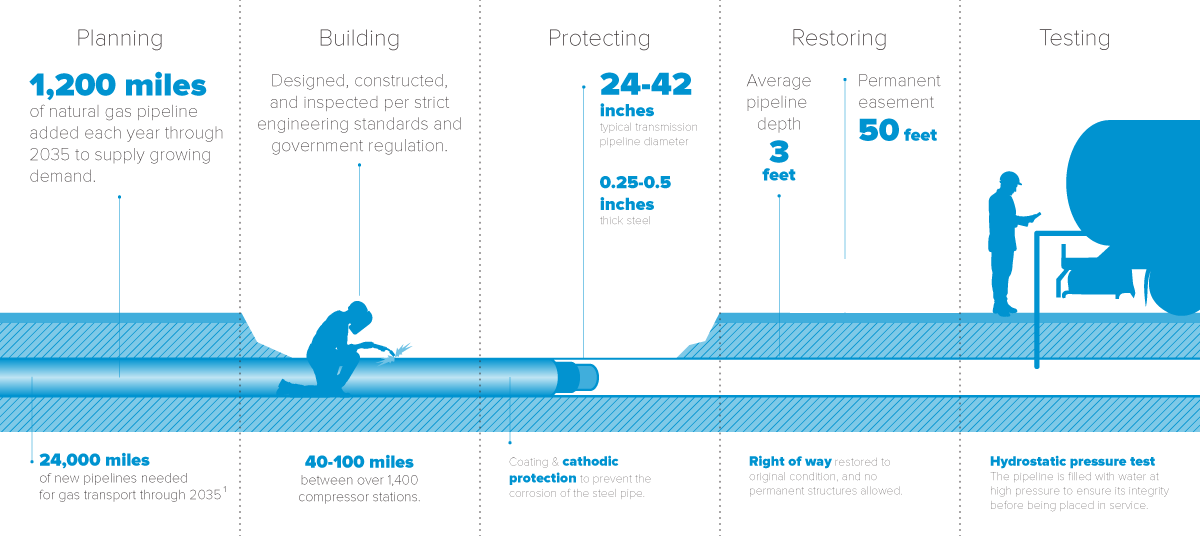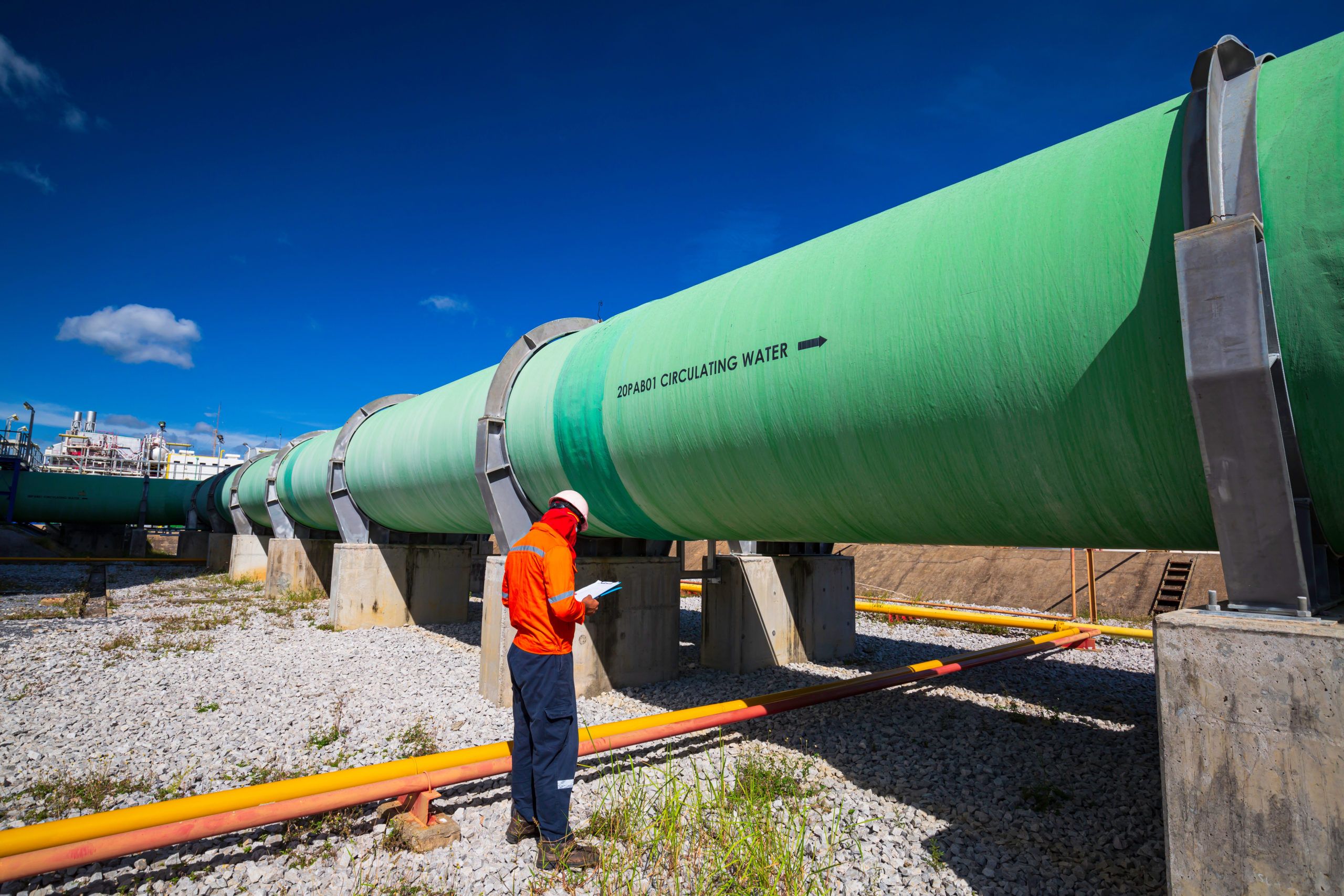Construction
Natural gas pipeline construction boomed in the past decade due to the abundance of natural gas made available by the shale revolution. The shale revolution really started to take off in 2006, and with that came the need to build new pipelines to transport that gas from producer to end-user.

More than 300,000 miles of interstate natural gas pipelines provide a vital link between producers and consumers. But most people are unaware of the presence of the interstate pipeline network that is operating safely and reliably underground.
During the construction process, our members follow, and often exceed the highest federal and engineering standards to ensure the safety and reliability of our systems. But our commitment to safety does not stop at construction.
The pipeline right-of-way, or the land 50 feet on either side of the pipeline route, is restored as closely as possible to its original condition and marked with signage to advise people that a pipeline is buried underground. Pipeline operating companies maintain and regularly inspect each pipeline after it is placed into service and throughout its lifetime to ensure safety and reliability.
Landowners have rights in the planning process before, during, and after construction. Stakeholder input plays a major role in the decision-making process when determining the eventual route of a new pipeline. The pipeline’s right-of-way is maintained by its operating company, but the land is returned to the landowner for their continued use when construction is complete. Once in service, operators continually provide information to landowners about any routine maintenance, expansions, or potential safety hazards.
INGAA members affirmed its commitments to landowners in a document called ‘America’s Natural Gas Transporters’ Commitment to Landowners’.
98 percent of the natural gas used in the U.S. comes from North America. INGAA members operate over 202,000 miles of natural gas pipelines. That’s enough to wrap around the earth more than eight times!
If all the 2.2 million miles of natural gas pipelines in the U.S. were connected to each other they would stretch to and from the moon almost nine times.
Pipeline leaks are rare, but being able to recognize and respond to a suspected leak or rupture is an important part of living and working safely around underground pipelines.
Signs of a natural gas pipeline RUPTURE:
Loud roaring or explosive sound; OR
Very large flames and loud roaring noise
Signs of a natural gas pipeline LEAK:
Rotten egg odor
Dead vegetation over or near the pipeline
Pigs are used to inspect pipelines. No, not the farm animals, but robotic devices called pigs because of the squealing sound they make when they travel through the pipelines. “Smart” pigs are used to evaluate the inside of the pipeline and ensure that they are safe. Pigs can ensure proper pipe structure, detect signs of corrosion or leaks and also can be used to clean the lines. Smart pigs are just one of the many ways that the pipeline industry ensures safety. Pipeline operators also conduct routine aerial and walking inspections of the pipeline and they monitor the pipeline’s pressure 24/7.
As with any surface, the inner walls of our pipelines are not perfectly smooth which leads to some friction when a product like natural gas flows through them. Even a small amount of friction will cause some pressure loss after the natural gas has passed through the pipeline for many miles.
A pipeline company must install compressors along the pipeline to re-pressure the natural gas so it may continue to flow. Compressor stations are typically installed at intervals of 30 to 70 miles (approximately 48 to 112 kms) along the pipeline.
Pipelines are constructed using different material depending on their size, pressure requirements and use.
Transmission and gathering pipes, the pipes used to transport gas from supply areas to distribution centers, are made of 0.25-inch to 0.5-inch thick steel and have a special coating to protect against corrosion.
For distribution pipelines, used by your local gas company to deliver to your home, plastic often is used because it is resistant to corrosion, flexible, and cost-effective especially lines which operate at less than 100 pounds of pressure.
The top of a natural gas transmission pipeline generally is at least 30 inches (2.5 feet) below the ground’s surface when installed, but that can vary depending on the size of the line, soil type and the terrain.
The following are a few of the agencies that regulate natural gas pipelines:
The Federal Energy Regulatory Commission (FERC) regulates such things as natural gas transportation rates, pipeline capacity, pipeline siting and natural gas quality requirements.
The U.S. Department of Transportation (DOT) Pipeline and Hazardous Materials Safety Administration (PHMSA) and their state and local agents provide regulation for the safe transportation of natural gas through pipelines.
The U.S. Environmental Protection Agency (EPA), the Fish and Wildlife Service and state environmental protection agencies provide regulations for protection of the environment and cultural resources during the construction and operation of pipeline facilities.
The U.S. Occupational Safety and Health Administration (OSHA) provides regulation for the safe working place for personnel.
Natural gas pipeline easements have had little or no effect on property values historically.
Integra Realty Resources, a leading provider of real estate valuation and counseling services, conducted a rigorous study of properties in four separate areas of the country in 2015. The report, Pipeline Impact to Property Value and Property Insurability, prepared on behalf of the INGAA Foundation, shows that the presence of pipelines does not affect the value of a property, its insurability, its desirability or the ability to obtain a mortgage.
After construction, the temporary right of way is restored to make sure that the foliage and grassland is returned as closely as possible to its original condition. Agricultural lands will be properly restored using approved mitigation techniques designed to ensure full productive reuse of the agricultural lands. Land representatives will meet with all directly affected landowners to assess any particular issues or concerns that the landowner may have, such as impact to landscaping or structures such as fences, sheds or playground equipment.
Pipeline construction jobs are normally done in six to eight weeks.
The Federal Energy Regulatory Commission is charged by Congress with evaluating whether interstate natural gas pipeline projects proposed by private companies should be approved. The federal government does not propose, construct, operate, or own such projects. The commission’s determination whether to approve such a project may affect you if your land is where a natural gas pipeline, other facilities, or underground storage fields might be located. FERC has issued a handy guide, An Interstate Natural Gas Facility on My Land? What Do I Need to Know?, for your information.
This guide covers:
How the Federal Energy Regulatory Commission’s procedures work;
What rights landowners have;
How the location of a pipeline or other facilities is decided;
What safety and environmental issues might be involved.
INGAA’s members live and work in these communities where projects are built and have committed to having a long-term relationship as your neighbor. INGAA members affirmed its commitments to landowners in a document called ‘America’s Natural Gas Transporters’ Commitment to Landowners.’
Yes. Any land disturbance for pipeline construction is temporary. Pipeline construction crews work to restore the land to its previous state. With the exception of pipeline safety markers located at each crossing of a public road and railroad and anywhere else necessary to identify the location of a pipeline, underground gas pipelines are largely invisible as they transport energy.
After a line is built, you can carry on normal farming operations, including crop growing and grazing. And because pipelines have at least 36 inches of soil cover, there should be no obstacles to normal irrigation or cultivation. You cannot plant trees on pipeline rights-of-way, nor can you build homes or business facilities. These restrictions are in place for safety and for pipeline maintenance purposes. They also may affect the value of the land, which will be reflected in the compensation that the landowner receives from the pipeline company.
After construction of the pipeline, the company will periodically inspect the site to ensure it is being properly maintained. Inspections are done from airplanes as well as on foot. It is the responsibility of the pipeline company to maintain the site, through such activities as mowing fields and clearing trees. These maintenance activities help the company properly inspect the site.






